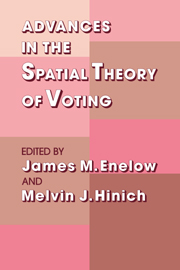Book contents
- Frontmatter
- Contents
- Foreword
- ADVANCES IN THE SPATIAL THEORY OF VOTING
- 1 Introduction
- 2 Multiparty Competition, Entry, and Entry Deterrence in Spatial Models of Elections
- 3 Heresthetic and Rhetoric in the Spatial Model
- 4 Spatial Strategies When Candidates Have Policy Preferences
- 5 A Decade of Experimental Research on Spatial Models of Elections and Committees
- 6 Candidate Uncertainty and Electoral Equilibria
- 7 The Theory of Predictive Mappings
- 8 Multicandidate Spatial Competition
- 9 The Setter Model
- Author Index
- Subject Index
7 - The Theory of Predictive Mappings
Published online by Cambridge University Press: 05 March 2012
- Frontmatter
- Contents
- Foreword
- ADVANCES IN THE SPATIAL THEORY OF VOTING
- 1 Introduction
- 2 Multiparty Competition, Entry, and Entry Deterrence in Spatial Models of Elections
- 3 Heresthetic and Rhetoric in the Spatial Model
- 4 Spatial Strategies When Candidates Have Policy Preferences
- 5 A Decade of Experimental Research on Spatial Models of Elections and Committees
- 6 Candidate Uncertainty and Electoral Equilibria
- 7 The Theory of Predictive Mappings
- 8 Multicandidate Spatial Competition
- 9 The Setter Model
- Author Index
- Subject Index
Summary
The problem of instability in social choice is often thought to be eliminated when the possible set of choices is one-dimensional, and voters have single-peaked preferences over this set. This is Duncan Black's (1958) famous median voter result. Yet, even if votes are determined solely by preferences, instability may still result. If linkages exist in the voters' minds between each possible choice along this single dimension and a future choice on other dimensions, the choice taking place in the voter's mind is multidimensional in nature. Thus, the instability that affects multidimensional social choice can afflict a social choice problem that is nominally one-dimensional. The question that arises is: Are these instabilities inevitable?
One answer is for an equilibrium point to exist in the multidimensional space, but the requirements for such an equilibrium are generally quite restrictive. A different answer comes from placing restrictions on the linkage, or predictive mapping, w that maps each possible choice in the nominal, one-dimensional set P of possible choices into an anticipated choice in the larger multidimensional space X. This second approach to studying stability conditions is the one taken in this essay. For each nominal contest between two elements pA and pB in P, the contest in the voter's mind is between w(pA) and w(pB), which are two points in X (or two probability distributions over points in X). Preference between pA and pB is then derived from the voter's preference between w(pA) and w(pB).
- Type
- Chapter
- Information
- Advances in the Spatial Theory of Voting , pp. 167 - 178Publisher: Cambridge University PressPrint publication year: 1990
- 4
- Cited by



